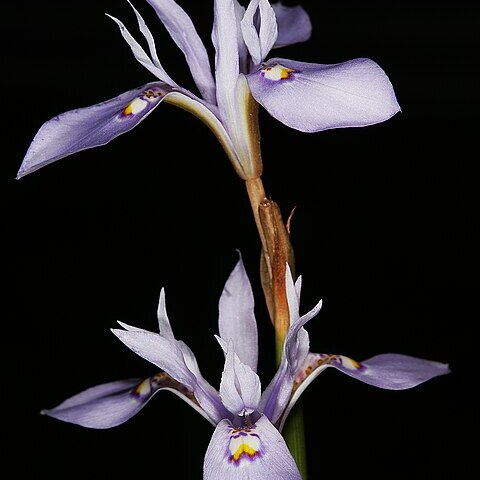Perennial herb, geophyte, 0.12-0.55 m high; corm tunics of dark brown, wiry fibres; stem usually simple, erect. Leaf 1, linear, canaliculate to terete, margins slightly rolled. Spathes herbaceous, attenuate, margins and apex brown, membranous to dry. Inflorescence with blue-violet flowers; nectar guides yellow; tepals unequal, spreading, outer 19-30 mm long, inner 15-24 mm long, entire, with expanded limb, linear-lanceolate. Stamens: filaments 3.5-4.0 mm long, united in lower half; anthers 5-6 mm long, appressed to style branches; pollen yellow. Ovary 6-8 mm long; style branches 8-10 mm long; crests 5-10 mm long, erect. Flowering time Sept.-Mar. Capsule ± obovoid.
Cormous geophyte, up to 0.55 m high, without pubescence. Leaf solitary, basal or inserted above ground, linear, margins inrolled. Flowers: anthers shorter than style branches, concealed by outer segment claws; style branches broad and flat; crests prominent; perianth with outer spathes green or brown, outer and inner segment limbs reflexed, segment claws 8-12 mm long, segments blue-violet with yellow to orange nectar guides on outer segments; Dec.-May. Fruit an ovoid to elliptic capsule.
Foliage leaf solitary, inserted near, to well above ground level, exceeding the inflorescence, linear and channelled to apparently terete with the margins tightly inrolled, an adaxial groove is usually present; sheathing leaves 2.5–4.5(6) cm long, green with dry brown attenuate apices.
Flowers blue-violet with yellow to orange nectar guides on the outer tepals; outer tepals 19–30 mm long, limb c. 18 × 9–12 mm, spreading; inner tepals 15–24 × 2–4 mm, narrowly lanceolate to nearly linear, limb spreading when fully open.
Cormous herb, up to 0.55 m high. Outer and inner tepal limbs reflexed. Style branches broad and flat. Crests prominent. Flowers blue-violet with yellow to orange nectar guides on outer tepals.
Rhipidia single per ultimate branch; spathes green, becoming dry and brown above, the inner 4–5(6) cm long, the outer c. 1 cm shorter than the inner.
Corms 1–2 cm in diameter; tunics of dark-brown, medium to coarse fibres often extending upwards as a short neck.
Cormous geophyte, 15-50 cm. Leaf solitary, linear, channelled. Flowers blue-violet with yellow markings.
Ovary 6–8 mm long, partly to fully exserted; style branches c. 8–10 mm long, crests 5–9 mm long.
Cataphylls membranous, becoming dry and brown, ultimately fragmenting irregularly.
Filaments 3.5–4 mm long, free in the upper half, anthers 5–6 mm long.
Stem more or less erect, simple or 1–3(8)-branched.
Capsule 9–12 × 4–5 mm, broadly obovoid.
Plants 12–55 cm high.
A herb or bulb plant.

